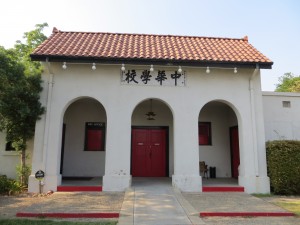The California State Society Daughters of the American Revolution (CSSDAR) is recognizing a representative group that helped with the development and growth of our nation, state and local communities, by placing a DAR Historical Marker at the Chinese School in Hanford on Saturday, June 7.
In California, the primary influence of the Chinese began in the mid-19th century, when Chinese immigrants came to work in the gold fields of northeastern California. As the gold rush wound down, the hardworking laborers were enlisted to work on the first transcontinental railroad. Most of the Chinese workers came without t

heir families, to earn money to send home to impoverished areas of China. It was their intention to reunite as the men settled into life in California. A very small number of women did come to California, but most were either wives of Chinese merchants or became part of the “entertainment” industry.
Though their labor was necessary, the Chinese were not welcomed by other workers because they were seen as competition. The new immigrants were willing to do the backbreaking work for less money. Animosity grew and laws were passed that encouraged greater prejudice and even more discrimination. The 1870’s saw many massacres and forced relocations of the Chinese migrants into what became known as “Chinatowns.” They isolated themselves for protection and cultural community. These Chinatowns formed in several areas of northern California; one in particular was established in Hanford and became known as China Alley.
Even though they were not encouraged or allowed to assimilate into the community culture of Hanford, the Chinese had a positive impact on local commerce and the economy. They influenced agriculture by introducing their long-practiced farming methods. They were recognized for their knowledge in Eastern medicine and were sought for treatment by members of all ethnic groups. The industrious Chinese people recognized needs in the community and provided services like restaurants, laundries and grocery stores. Several present-day restaurants and markets in Hanford came from humble beginnings in China Alley.
Education was highly prized, as was Chinese heritage. In order for children to learn of their culture and heritage, the Chinese community established a schoolroom in the basement of the Sue Chung Kee store with Y.T. Sue as teacher. After a short time, the classroom was moved next door to a room in the Taoist Temple. By 1922, the need was realized for a larger school and funds were raised to provide a permanent location for their children’s cultural education, grades K-12.
The curriculum included Chinese customs, culture, philosophy and literature, as well as oral and written language in order to see that their families’ heritage and personal histories were preserved. Children attended after their school day at the local public school as well as on Saturday. Within 30-35 years, however, the Chinese community diminished in size, families with school-aged children moved from the area, and the school was closed.
Rather than demolish the building, the people of Hanford found another use for it, a way that has preserved it for 50 years. In 1964, a three-way contract with the Kings Players, the Chinese community and the City of Hanford was established. The building is now used regularly to provide another cultural dimension, live theatre, to the entire community. The building itself is still known as the Chinese School and serves as a reminder of the many years the Chinese of the area were committed to retaining their language and customs, giving their children the understanding of where they came from as they prepared for their future.
California DAR State Regent Debra Parent Jamison grew up in nearby Lemoore. It was her desire to request that the National Society DAR allow the California State Society to place a DAR historical marker in the locale where she spent so much time with friends in Hanford.
The National Society Daughters of the American Revolution was founded in 1890 to promote patriotism, preserve American history and support better education for our nation’s children. Its members are descended from the patriots who won American independence during the Revolutionary War. With more than 175,000 members in approximately 3,000 chapters worldwide, DAR is one of the world’s largest and most active service organizations.
To learn more about the work of today’s DAR, visit www.DAR.org.
